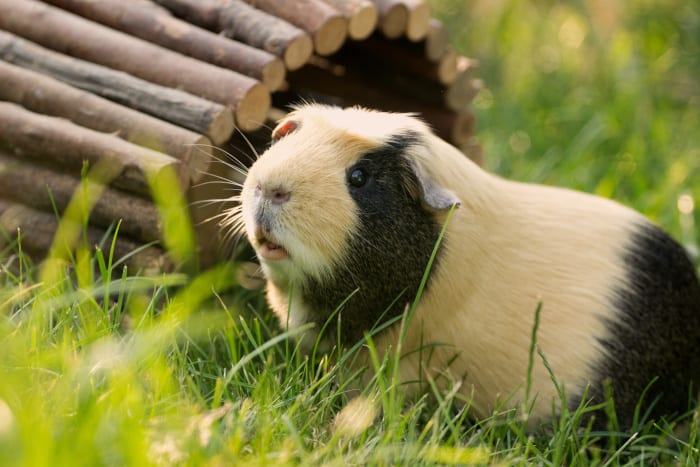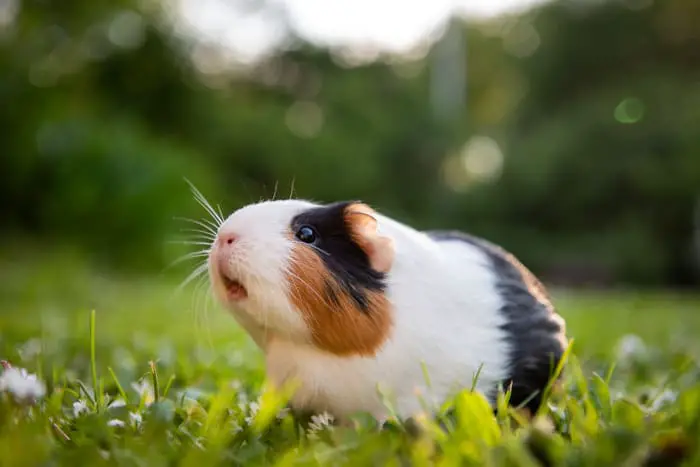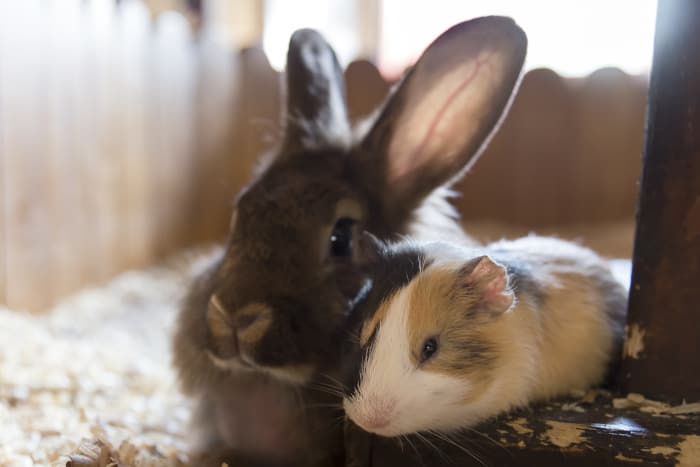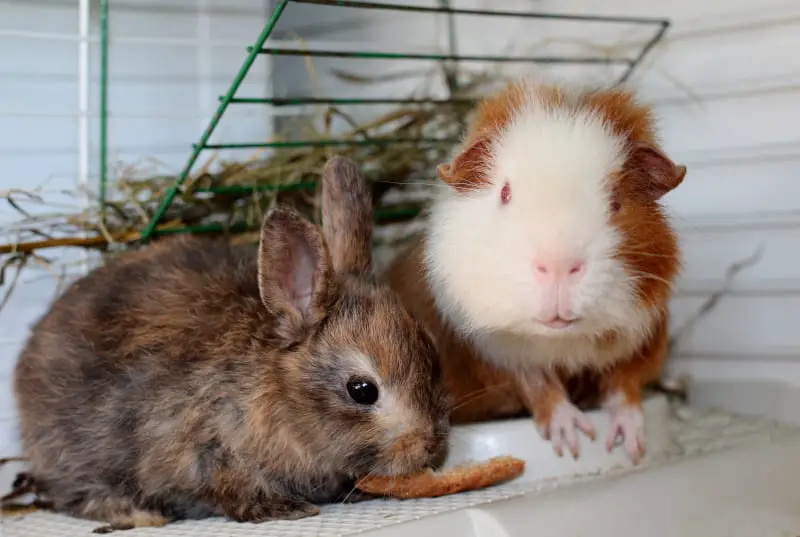Our topic for today is Bunnies vs. Guinea Pigs. Indeed, this is a tough decision to make as both species are adorable and can make great pets.
You have certainly come this far because you are looking for the ideal pet and don’t know whether to go for a rabbit or a guinea pig.
Well, given this intense battle, we invite you to continue reading so that you can clear up all your doubts and make the decision that suits you best.
Let’s Meet the Guinea Pigs
Before we highlight the differences and similarities between these two species, let’s learn a little more about our guinea pig friends.
Unlike rabbits, which are lagomorphs, guinea pigs are rodents. These small animals are native to the Andean regions of South America and Peru, Chile, Argentina, and Bolivia. Although guinea pigs have ceased to exist in the wild for centuries, in these countries, there is still the “poronccoy” (or montane guinea pig) which is a type of wild guinea pig that is considered the ancestor of today’s domestic guinea pig.
How Did Guinea Pigs Get to Europe?
Guinea pigs were brought to Europe by Spanish navigators during the discovery era in the 15th century and gradually became popular as pets.
Although they still make a food source in some countries and serve as research animals in laboratories, these sweet animals are becoming more popular as pets due to their adorable appearance and loving character.

Time for the Great Battle
Like all pets, guinea pigs have unique characteristics and require particular care to grow happy and healthy. A guinea pig that has been well-cared-for guinea pig can live up to 8 years.
This article will review these characteristics and needs and compare them with the rabbits to give you a clearer idea of both pet types. We will emphasize the aspects of the guinea pigs since, in many other articles, we have already described the rabbits in depth.
Physical Appearance
As for their physical appearance, guinea pigs are usually smaller than rabbits, suggesting an advantage for small spaces. For you to have a much clearer idea, the toy or dwarf rabbit can reach a total length of around 33 or 50 centimeters. Guinea pigs can get a full size of 20 or 25 cm.
Another characteristic that differentiates guinea pigs from bunnies is their ears. If you’re a fan of long ears, then a guinea pig is not for you, as they have tiny ears.
Being rodents, guinea pigs have a unique pair of incisors on the top, which, like rabbits, never stop growing. But despite being rodents, guinea pigs tend to chew less than rabbits.
Space
If you are looking for a pet companion for a small space like an apartment, guinea pigs are ideal. Unlike rabbits, which come in different sizes from dwarfs to giants, guinea pigs are tiny, reaching between 20 and 25 cm in adulthood. But despite their small size, they need adequate space.
Many experts recommend that the guinea pig’s cage or home measure no less than 2.5 square meters. This cage should have bars resistant to chewing, and it is not advisable to install them outside the house as guinea pigs cannot withstand extreme temperatures.
The cage should be placed inside the house where they can smell you and interact with people, as they easily integrate into the families. Also, you should let them relax by walking around your house freely from time to time so they can play and run around.
On the other hand, bunnies will need larger cages and spaces, and they must get out of their cells to explore and play daily.
Company and Human Contact
Unlike rabbits, which can adapt to living alone and may have a little more trouble adjusting to their new environment, guinea pigs need to interact with other guinea pigs and their owners to feel happy. These small animals are used to living in herds, so you will have to adopt two or more guinea pigs to keep them company.
Guinea pigs are gregarious animals, highly sociable, and need to live in groups to be happy, healthy, and have a long life. Although they are entirely domesticated, they have not existed in the wild for centuries. Their instinct inclines them to live in groups, and they are used to doing everything together, like playing, eating, and sleeping. This way of life protects them from predators because the more guinea pigs there are, the greater their survival chances. Although many people wonder about having more than one pet, the reality is that being so small animals, having more than one does not pose a big problem.
Also, they like to have contact with their owners, so don’t be surprised if they welcome you with little squeals of joy when you get home.
They Emit Sounds
Unlike pet rabbits, which tend to be quieter, guinea pigs make sounds. They use a wide range of sounds to communicate with each other and with us humans. Their name in Spanish is “cobaya” and derives from the main sound they emit, “cui-cui.”
Experts say guinea pigs can emit up to 8 different sounds. As you learn to know your little friend, you will also learn to distinguish the meaning of each sound.
The fact that they can emit sounds can be an advantage or a disadvantage; it all depends on your taste. If what you like is absolute silence and not to be asked for attention, then the rabbit is for you. If you prefer your pet to communicate with you, then choose the guinea pig.

Breeds
In this aspect, our friends the rabbits take the lead, as there are more than 50 breeds of rabbits to choose from, and they come in different sizes, length of fur, and colors. Dwarf rabbits are very popular among people who live in apartments and who prefer a small pet. In reality, the difference between a dwarf rabbit and a guinea pig is not that great.
However, we cannot underestimate the guinea pigs. There are many varieties, and these differ in color and type of fur. According to their coat, these animals are classified into short-haired, long-haired, and hairless guinea pigs.
- Short-haired guinea pigs: Among those with short hair, we find Americana, Self Teddy, and Rex.
- Long Hair Guinea Pigs: Within the long hair are Peruvian, Coronet, Abyssinian, and Sheltie.
- Hairless Guinea pigs: Skinny and Baldwin
Just like rabbits, long-haired guinea pigs need a daily brush to keep their fur in good condition and free of knots.
Feeding
Like rabbits, guinea pigs are strictly herbivorous animals; their digestive system can only process raw food of vegetable origin. Being a domesticated species, they depend on human beings to obtain a correct diet. Their diet is very similar to that of the rabbits, only in lesser quantity. Also, guinea pigs need an extra vitamin C supply, so their diet should include plenty of vegetables with this vitamin.
The ideal diet of a guinea pig is composed of:
- 80% high-quality hay
- 15% of vegetables (vegetables, fruits, and plants suitable for guinea pigs)
- 5% special feed for guinea pigs
- Snacks occasionally
- Freshwater is a must every day
- Vitamin C supply
- Vegetables and fruits as a prize
We must consider that the diet must be adapted to each guinea pig’s individual needs, such as age, weight, or health conditions, so the veterinarian will be your best help in determining which diet is best for your pet. Drastic changes in diet should be avoided. All diet changes should be progressive to give their digestive system time to adapt; otherwise, they could even suffer intestinal occlusions that could lead to death.
Like rabbits, guinea pigs’ teeth also need attention. If they are given abundant food rich in fiber, like hay, it will make their teeth in perfect condition.
Cleaning the Cage
Guinea pigs love to have privacy; you can place a small chamber inside the cage for this purpose. To cover the floor, you should use an absorbent material in the hygienic area and clean it every day. Among the materials, you could use hay, recycled paper, wood pulp, and wood shavings. Unlike rabbits, guinea pig droppings are smaller, and if cleaned properly, they tend to smell less.
One of the advantages that guinea pigs have over rabbits in terms of their cages is that fewer materials are used to cover the floor because their enclosure is smaller, and also, it would be easier to clean.
You Can Bathe Your Guinea Pig
Another difference between rabbits and guinea pigs lay in their cleaning. Unlike bunnies, guinea pigs can be bathed with a special shampoo, although this should not be done too often, as they need the natural oils produced by their fur to protect their skin. A bath every 3 or 4 months is more than enough.
Summary

Although we have already discussed the essential characteristics and differences between rabbits and guinea pigs, it can still be challenging to choose one or the other since both are quite similar, and many rabbit breeds can be almost identical in size.
To sum up, if you are looking for a small pet that does not make any noise and adapts to being alone, a dwarf rabbit is your best option. If, on the other hand, you want a small pet but do not mind having more than one and hearing the occasional adorable sound, then consider buying a little guinea pig.

